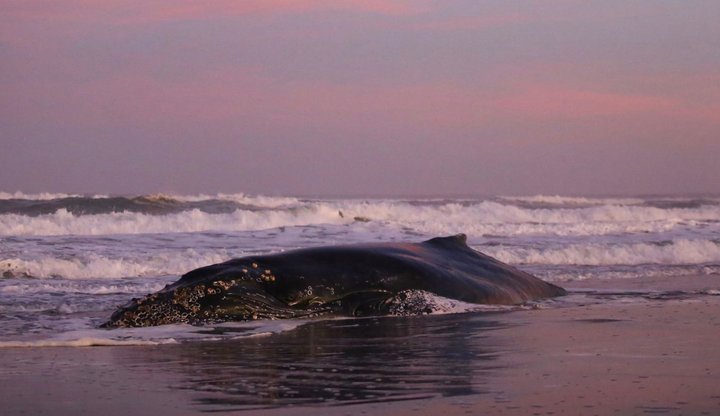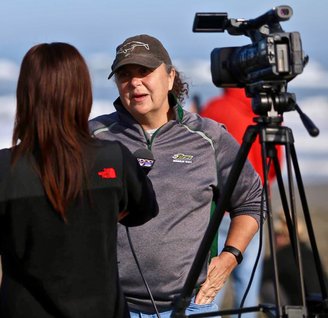
Photos by Andrew Goff.
# # #
PREVIOUSLY
- A Whale Caught in Fishing Nets has Washed Ashore North of Samoa
- WEDNESDAY NIGHT WHALE UPDATE: Alive, But Still Beached in the Surf Zone
- (UPDATES) MORNING WHALE UPDATE: The Samoa Whale is Still Stranded, but Still Alive
- The Whale is Dead
# # #
This week’s story of a humpback whale stranded on Samoa Beach ended tragically Thursday evening when veterinarians and marine mammal experts made the difficult decision to euthanize her. (Examinations conducted since her death revealed that the whale was female.)
As onlookers from Humboldt County and beyond watched the excruciating drama unfold, both online and in person, many felt compelled to offer suggestions for what could or should have been done to save the massive creature.
These recommendations ran the gamut from the seemingly plausible (digging a trench and towing it out with a harness) to the plainly ridiculous (lifting it with a helicopter or a dirigible). And the tone of these proposals ranged from tortured and pleading to smug and outright hostile.

Dawn Goley speaks to a TV news reporter at the scene.
On Friday the Outpost spoke with HSU professor and marine mammal stranding expert Dawn Goley, who served as the local lead in this crisis, as well as Justin Viezbicke, the California stranding network coordinator with NOAA fisheries, who helped lead the decision-making process. We asked them to address some of these ideas.
“First,” Goley said, “I wanted to just say we honestly, deeply considered all the different avenues that have been tried to help the whale leave the beach. We worked with experts around the world who have a lot of experience with [stranding]. Based on this particular situation, there wasn’t a safe and effective way to do that where the whale would be uninjured and people would be safe.”
Those are the two paramount considerations, Goley said — the safety of the public and the wellbeing of the animal.
Viezbicke agreed. “We are open to having discussions about removing whales from a beach … but when you’re working with government, human safety will always be paramount,” he said. “We’re not willing to trade a human life for that whale’s life.”
The whale was injured both externally and internally. She had been ensnared in crab fishing gear — for how long was uncertain. But even after she was freed from the ropes, the whale was mobile, periodically swinging her flukes, rolling on her side and flapping her flippers. “Those are powerful and can be deadly,” Goley said.
At roughly 30 feet long, this adult humpback weighed somewhere around 18 to 20 tons, according to Goley. So the idea that the people could simply push her into the ocean was unrealistic.
“We’ve tried this even with dead whales and people still can’t move them,” Goley said. “And it risks mortal injury.”
The other most popular idea, after pushing the whale, was pulling it — perhaps with a harness attached to the tail.
”From what we’ve learned from all of NOAA’s broad interests across the country, [including] veterinarians and other experts, there’s a lot of concern about the pushing and pulling of whales,” Viezbicke said. “Attaching a harness to flukes can be problematic. It can cause bad damage and can actually kill the whale. The big issue is gravity.”
A number of people on social media posted links to YouTube videos showing whale rescues, but Viezbicke said many such videos depict smaller whales. Others may show apparently successful rescues but don’t necessarily tell the whole story.
For example, in 1993 a high-powered Exxon workboat managed to pull a 40-ton humpback off a beach near Santa Barbara. But Viezbicke said the operation left a lot of questions unanswered. Video shows people working dangerously close to the powerful fluke in order to secure a tow line. And according to the official report, the whale was not dragged smoothly from the shore; rather, the vessel pulling it allowed slack in the line and then gunned the engine, yanking on the fluke to drag it into the sea.
“They had to do that three times,” Viezbicke said. “That is not very good for those animals. … The reality is we don’t actually know what happened to the whale after it was pulled off the beach.”
Goley said yanking a whale by its fluke often causes irreversible internal and external damage. In fact, after the humpback here on Samoa Beach was euthanized, it got hauled up out of the surf zone so it could be thoroughly examined, and Goley said just dragging it that far resulted in a cut that penetrated almost all the way through the whale’s fluke.
Some people suggested using an excavator or other heavy equipment to dig a trench out into the sea, There’s a couple reasons why that wouldn’t have worked, Goley said. “One, the excavator can’t really operate in eight-foot sea, and two, the width and depth you’d have to build that path would be impossible to maintain. If you’ve ever dug a hole at the beach and a wave comes in, what happens? It fills in.”
As for lifting it, the world’s largest heavy-lift helicopters may technically be capable of raising the whale’s weight, but the harnessing problems down at beach level would still apply. You can’t simply roll a humpback onto a rescue stretcher.
One other suggestion was to employ the massive (up to 1,200-foot-long) bags produced by Scotia-based company AquaDam to essentially flush the whale off the beach — releasing tens of thousands of gallons of water from up the slope in hopes of dislodging the whale from the surf zone.
Goley said the people in the stranding network are open to considering “any idea at all,” but this one — which she’d never heard before — didn’t sound feasible, either. Being struck with a wall of water would probably only cause the whale stress and confusion.
“I can imagine the whale would not perceive that as an opportunity to swim calmly offshore,” Goley said. “The whale would shut down because that would be such a shock.”
As soon as a whale gets stranded on land, its biological stress response begins, along with the physical distress of being smothered by its own weight.
Many onlookers voiced frustration at seeing law enforcement and the response team apparently just standing around while the whale suffered.
“Part of what was perceived as not caring was us trying to avoid having the whale be stressed more,” Goley said. And they weren’t just standing around; she and others were in regular communication with experts in the stranding community throughout the ordeal.
“The narrative that we don’t care and that we weren’t engaged and communicating is just not our reality,” Goley said. “We deeply care. We love our community and value their input.”
“We want the public to understand that these are not easy decisions,” Viezbicke said. “There were a lot of discussions and consultations [regarding] what’s the best thing to do for this animal. The reality is that given the resources we have, the feasibility and the condition of the whale, it really moved us in the direction of thinking this animal wasn’t going to do very well even if we got it off the beach. So we went with humane euthanasia.”
The public’s frustration is understandable but largely misplaced, he added.
”People need to understand that the stranding network folks are not the ones to be mad at,” Viezbicke said. “If there’s anything to be concerned with it’s [the question of] why these whales are coming ashore. That means the fishery, particularly the Dungeness fishery.”
Whale entanglements from lost or abandoned crab gear along the west coast have been a problem for years. In 2015 a record 57 whales were entangled off the California coast alone. The Whale Protection & Crab Gear Retrieval Act, a bill from State Senator Mike McGuire, was passed into law three years ago.
But according to Viezbicke the fishery has seen no significant changes to the incidence of entanglements. There have been about 25 of them this year, which is lower than previous years “but way higher than what’s acceptable,” he said.
CLICK TO MANAGE